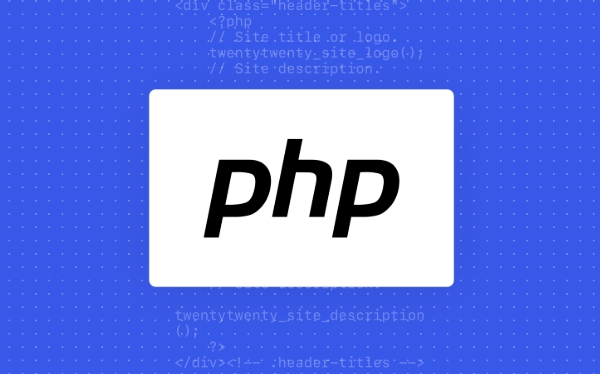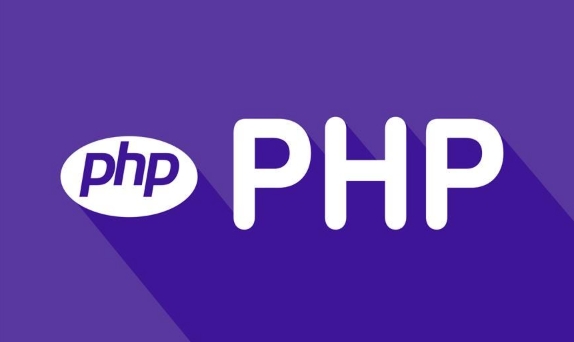 Backend Development
Backend Development
 PHP Tutorial
PHP Tutorial
 Decoding the Server-Side: Your First Steps into PHP's Architecture
Decoding the Server-Side: Your First Steps into PHP's Architecture
Decoding the Server-Side: Your First Steps into PHP's Architecture
Jul 27, 2025 am 04:28 AMPHP runs on the server side. When the user requests the page, the server executes the code through the PHP engine and returns HTML to ensure that the PHP code is not seen by the front end. 1. Request processing: Use $_GET, $_POST, $_SESSION, $_SERVER to obtain data, always verify and filter inputs to ensure security. 2. Separation of logic and display: Separate data processing from HTML output, use PHP files to process logic, and template files are responsible for displaying, improving maintainability. 3. Automatic loading and file structure: Configure PSR-4 automatic loading through Composer, such as "App\": "src/", to automatically introduce class files. The recommended project structure is: public/storage entry index.php, src/storage class, config/storage configuration, views/storage templates, composer.json management dependencies. Beginner steps: Install the PHP environment, configure Composer, process form $_POST, separate configuration and template files, use var_dump ($_SERVER) to view server information, and then you can expand routing, automatic loading and PDO database connections. Master these core architectural principles and be able to build scalable, secure, and easy-to-maintain PHP applications starting from small projects.

So you've decided to dive into PHP — welcome to one of the most widely used server-side languages on the web. Whether you're building a simple contact form or planning to scale up to a full content management system, understanding PHP's architecture from the start will save you time, confusion, and bad habits down the road. Let's break it down in a way that makes sense, even if you're just stepping off the client-side (HTML/CSS/JS) ledge.

How PHP Actually Works Behind the Scenes
When someone says "PHP runs on the server," what does that really mean?
Imagine a user types your website's URL into their browser. Instead of sending them raw PHP files (which would be useless in the browser), the server processes the PHP code first. It executes things like database queries, user authentication, or dynamic content generation, then outputs plain HTML back to the browser.

Here's the flow:
- User requests
page.php - Web server (like Apache or Nginx) sees the
.phpextension - PHP engine (like PHP-FPM or mod_php) runs the code
- Final HTML result is sent to the user
- User never sees the PHP — just the result
This separation is key: PHP is invisible to the front end . It does its job behind the curtain.

The Core Building Blocks of PHP Architecture
You don't need a framework on day one, but you should understand the foundational pieces that make PHP scalable and organized.
1. Request Handling
Every PHP script starts with a request. Whether it's a page load or an API call, PHP accesses data via superglobals like:
-
$_GET– for URL parameters -
$_POST– for form submissions -
$_SESSION– for user-specific data -
$_SERVER– for environment and server info
Keep in mind: never trust input. Always validate and sanitize $_GET and $_POST data — it's the first rule of secure PHP.
2. Separation of Logic and Presentation
Early PHP often mixes HTML and PHP like this:
<?php $user = "John"; ?> <h1>Hello <?php echo $user; ?></h1>
That's fine for learning, but quickly becomes messy. As you grow, aim to separate:
- Logic (data processing, business rules)
- Presentation (HTML output)
Even without a framework, you can do this manually:
- Use PHP files for processing
- Include template files that only display data
This small habit makes your code easier to debug and test.
3. Autoloading and File Structure
As your project grows, you'll have multiple files: classes, functions, config files. Instead of require -ing everything manually, use autoloading (PSR-4 standard is the modern way).
For example, with Composer:
{
"autoload": {
"psr-4": {
"App\\": "src/"
}
}
} Now, when you instantiate a class like new App\User() , PHP automatically finds src/User.php . No more require_once spaghetti.
Starting Simple, But Thinking Ahead
You don't need Laravel or Symfony to start — but you should think about structure early.
Here's a beginner-friendly project layout:
/project-root │ ├── public/ │ └── index.php # Entry point (only public-facing) ├── src/ │ └── User.php # Classes go here ├── config/ │ └── database.php # DB settings ├── views/ │ └── home.php # HTML templates └── composer.json
Key idea: only public/ should be accessible from the web. This keeps your source code safe.
A Few First Steps to Take Now
If you're just starting, focus on these:
- [ ] Install PHP locally (use XAMPP, MAMP, or Laravel Valet)
- [ ] Get Composer working (essential for modern PHP)
- [ ] Write a script that handles a form with
$_POST - [ ] Try including a config file and a template separately
- [ ] Use
var_dump($_SERVER)to see what's available
Once you're comfortable with that, explore:
- Simple routing (map URLs to functions)
- Basic autoloading with Composer
- Connecting to a database with PDO
Basically, PHP's architecture isn't about complexity — it's about control. You're running code where it belongs: on the server, securely, with full access to data and system resources. Start small, keep things organized, and let the structure grow with your understanding.
That's how you build something that scales — without rewriting everything twice.
The above is the detailed content of Decoding the Server-Side: Your First Steps into PHP's Architecture. For more information, please follow other related articles on the PHP Chinese website!

Hot AI Tools

Undress AI Tool
Undress images for free

Undresser.AI Undress
AI-powered app for creating realistic nude photos

AI Clothes Remover
Online AI tool for removing clothes from photos.

Clothoff.io
AI clothes remover

Video Face Swap
Swap faces in any video effortlessly with our completely free AI face swap tool!

Hot Article

Hot Tools

Notepad++7.3.1
Easy-to-use and free code editor

SublimeText3 Chinese version
Chinese version, very easy to use

Zend Studio 13.0.1
Powerful PHP integrated development environment

Dreamweaver CS6
Visual web development tools

SublimeText3 Mac version
God-level code editing software (SublimeText3)

Hot Topics
 Crafting Interactive Web Experiences: An Introduction to PHP's Power
Jul 26, 2025 am 09:52 AM
Crafting Interactive Web Experiences: An Introduction to PHP's Power
Jul 26, 2025 am 09:52 AM
PHPremainsapowerfulandaccessibleserver-sidelanguageforcreatinginteractivewebexperiencesbecauseitenablesdynamiccontentgeneration,userauthentication,andreal-timedatahandling;1)itiseasytolearnandwidelysupported,integratingdirectlywithHTMLandmosthostingp
 Building Your First Dynamic Web Page: A Practical PHP Primer
Jul 29, 2025 am 04:58 AM
Building Your First Dynamic Web Page: A Practical PHP Primer
Jul 29, 2025 am 04:58 AM
Install XAMPP/MAMP or use PHP built-in server and make sure the file is saved as a .php extension; 2. Use display the current time in hello.php; 3. Get user input through $_GET in greet.php and use htmlspecialchars() to prevent XSS; 4. Use include'header.php'; multiplex the page header; 5. Enable error reports during development, variables start with $, use arrays to store data, and always filter user input. You have created a dynamic web page that can respond to user input, display dynamic content and reuse code. This is a key step towards a complete web application. You can connect to the database or build a login system in the future, but you should be sure of yourself at this time.
 Beyond the Basics: Unlocking Web Dynamics with PHP
Jul 25, 2025 pm 03:01 PM
Beyond the Basics: Unlocking Web Dynamics with PHP
Jul 25, 2025 pm 03:01 PM
PHPenablesdynamiccontentgenerationbasedonusercontextbyleveragingsessions,geolocation,andtime-basedlogictodeliverpersonalizedexperiencessecurely.2.ItmanagesstateinHTTP’sstatelessenvironmentusing$_SESSIONandcookies,withenhancedsecuritythroughsessionreg
 Server-Side Scripting Demystified: A Hands-On Introduction to PHP
Jul 27, 2025 am 03:46 AM
Server-Side Scripting Demystified: A Hands-On Introduction to PHP
Jul 27, 2025 am 03:46 AM
PHPisaserver-sidescriptinglanguageusedtocreatedynamicwebcontent.1.Itrunsontheserver,generatingHTMLbeforesendingittothebrowser,asshownwiththedate()functionoutputtingthecurrentday.2.YoucansetupalocalenvironmentusingXAMPPbyinstallingit,startingApache,pl
 The Cornerstone of the Web: A Foundational Guide to PHP Scripting
Jul 25, 2025 pm 05:09 PM
The Cornerstone of the Web: A Foundational Guide to PHP Scripting
Jul 25, 2025 pm 05:09 PM
PHPstillmattersinmodernwebdevelopmentbecauseitpowersover75%ofwebsitesusingserver-sidelanguages,includingWordPress(43%ofallwebsites),andremainsessentialforbuildingdynamic,database-drivensites.1)PHPisaserver-sidescriptinglanguagecreatedin1995tomakestat
 Decoding the Server-Side: Your First Steps into PHP's Architecture
Jul 27, 2025 am 04:28 AM
Decoding the Server-Side: Your First Steps into PHP's Architecture
Jul 27, 2025 am 04:28 AM
PHP runs on the server side. When the user requests the page, the server executes the code through the PHP engine and returns HTML to ensure that the PHP code is not seen by the front end. 1. Request processing: Use $_GET, $_POST, $_SESSION, $_SERVER to obtain data, and always verify and filter inputs to ensure security. 2. Separation of logic and display: Separate data processing from HTML output, use PHP files to process logic, and template files are responsible for displaying, improving maintainability. 3. Automatic loading and file structure: Configure PSR-4 automatic loading through Composer, such as "App\":"src/", to automatically introduce class files. Suggested projects
 The Genesis of a Web Application: A Primer on PHP and MySQL
Jul 28, 2025 am 04:38 AM
The Genesis of a Web Application: A Primer on PHP and MySQL
Jul 28, 2025 am 04:38 AM
To start building a web application, first use PHP and MySQL to build a local environment and create a user registration system. 1. Install XAMPP and other integrated environments, start Apache and MySQL services; 2. Create database and users table in phpMyAdmin, including fields such as id, username, password, etc.; 3. Write an HTML registration form and submit data to register.php; 4. Use PDO to connect to MySQL in register.php, insert data through prepared statement, and encrypt password with password_hash; 5. Handle errors such as duplicate username. This way you can master the server
 Embarking on Modern PHP: Syntax, Servers, and Composer
Jul 27, 2025 am 03:43 AM
Embarking on Modern PHP: Syntax, Servers, and Composer
Jul 27, 2025 am 03:43 AM
The core of modern PHP development is the three pillars of syntax, server and Composer. 1. Use modern PHP syntax: including PHP7.4 type attributes (such as publicstring$name), PHP8.0 union type (int|float), nullsafe operator (?->), match expressions and attributes metadata to improve code safety and readability, and declare declare(strict_types=1) at the top of the file to enable strict types. 2. Choose a suitable local development server: Abandon simple php-S and use LaravelSail, SymfonyCLI or Dock instead





